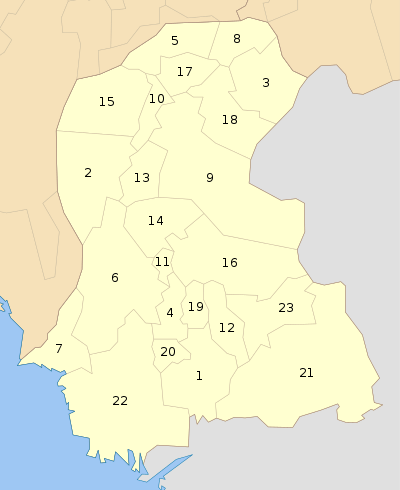Sanghar District
Sanghar District (Sindhi: ضلعو سانگھڙ : Urdu: ضلع سانگھڑ) is one of the largest districts of Sindh province, Pakistan. It has an area of 9874 square kilometres. It is located in the centre of Sindh and is bounded to the east by India. The district capital, Sanghar, is itself a small city roughly 35 miles (56 km) east-south-east of the city of Nawabshah and the same distance north of Mirpur Khas. Its primary industry is agriculture.
Sanghar District ضلعو سانگھڙ | |
|---|---|
 Sanghar is located in the centre of Sindh. | |
| Country | |
| Province | |
| Division | Shaheed Benazir Abad |
| Headquarters | Sanghar |
| Area | |
| • Total | 10,608 km2 (4,096 sq mi) |
| Population (2017)[2] | |
| • Total | 2,057,057 |
| • Density | 190/km2 (500/sq mi) |
| Time zone | UTC+5 (PST) |
| Number of Tehsils | 6 Khipro, Niabad, Tando Adam, Sinjhoro, Shahdadpur, Sanghar. |
| Website | www.sanghar.gov.pk |
The following cities are located in Sanghar District: Sanghar, Tando Adam, Jam Nawaz Ali, Shahdadpur, Shahpur Chakar, Sinjhoro, Jhol, among others.
Sanghar District is also known as the district of Hur mujhaid, who are follower of Muslim saint Syed Shah Mardan Shah-II. They also fought against British government under the command of Sibghatullah Shah Rashidi.
Administrative subdivisions
The district of Sanghar is administratively subdivided into 6 talukas:[3]
History
The town of Sanghar, the district headquarters, was formerly a small village that has been populated since the 18th century. It was named after a pious fisher-woman, Mai Singhar; for more than a century, it remained a small village with a population of few hundreds.
After the 1853 invasion by Charles Napier, Sindh was divided into provinces and was assigned zamindars, also known as "Wadera", to collect taxes for the British. Sindh was later made part of British India's Bombay Presidency, and became a separate province in 1935. During this period Sanghar obtained the status of Taluka, an administrative subdivision, and was alternatively included in districts of Nawabshah and Tharparkar. In 1954 it was given the status of District-Headquarters.
The people of the district, specifically the Hurs, played a vital role in independence of Pakistan. The Hurs were an organised military rebel group led by Pir Syed Sabghatullah Shah Pagaro Shaheed, popularly known as Pir Pagara, that sought independence from the British Raj. They fought a guerrilla warfare campaign against the British military, and were always a thorn in the side of British Raj. It has been said that this warfare was one of the major nails in the coffin of British Raj in India.
According to legend, the bodies of Sohni Mahiwal, the titular heroes of one of the four popular tragic romances of Sindh, were recovered from the Indus River near Shahdadpur city and are buried there. The Tomb of Sohni is situated in Shahdadpur, which is 40 kilometres (25 mi) from Sanghar and 75 kilometres (47 mi) from Hyderabad.
Places
- Mir Shahdad Jo Qubo, the tomb of Mir Shahdad Talpur, who is regarded as one of the finest military commanders of Sindh, is one of the historical heritages of Sindh and is located in Shahpur Chakar, at a graveyard of the family members of Mir Shahdad Talpur. Shahdadpur, a big city of Sindh Province, is named after Mir Shahdad Talpur, while Shahpur Chakar is named behind his son Mir Chakar Talpur.
- Mansura, ruins from the seventh century A.D. This site has been excavated by the government of Pakistan, and where the local folks go Gold-jewelry hunting after heavy rains. The rains wash off the top soil thereby exposing, among other artifacts, the ancient jewelry.
Demographics
According to the 1998 census of Pakistan, the district had a population of 1,453,028, of which 22.13% were located in urban areas.[4] 79% were Muslim, and 19% – Hindu.[5] Sindhi is spoken by 77% of the population, Urdu – by 10%, Punjabi – by 7.8%, and Balochi – by 1.7%.[6]
See also
- Cadet College Sanghar
- Jheol
- Sohni Mahiwal Tomb of Sohni in Shahdadpur.
- Sanghar City
References
- http://www.pbs.gov.pk/content/district-glance-sanghar
- "DISTRICT WISE CENSUS RESULTS CENSUS 2017" (PDF). www.pbscensus.gov.pk. Archived from the original (PDF) on 2017-08-29.
- DISTRICT GOVERNMENT - Sanghar Archived 2007-09-15 at the Wayback Machine
- Urban Resource Centre (1998 Census Figures) Archived 2006-05-13 at the Wayback Machine
- PCO 2000, pp. 18–20.
- PCO 2000, p. 20.
Bibliography
- 1998 District census report of Sanghar. Census publication. 75. Islamabad: Population Census Organization, Statistics Division, Government of Pakistan. 2000.
